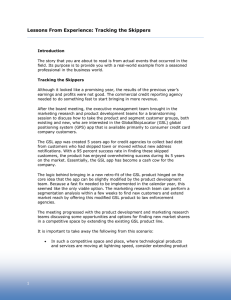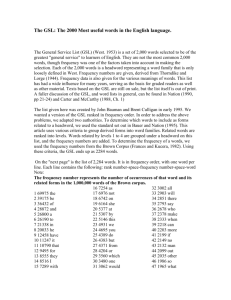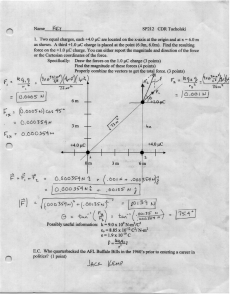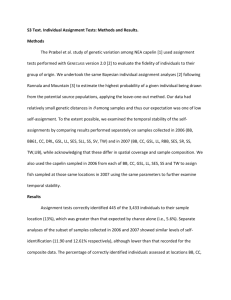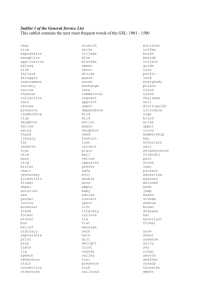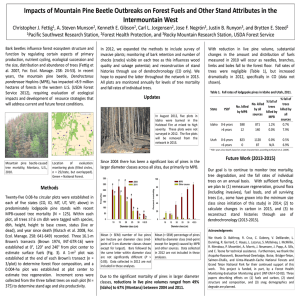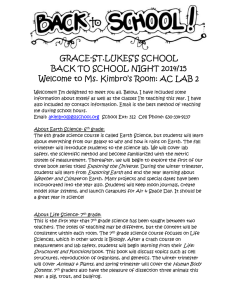Document 11790892
advertisement
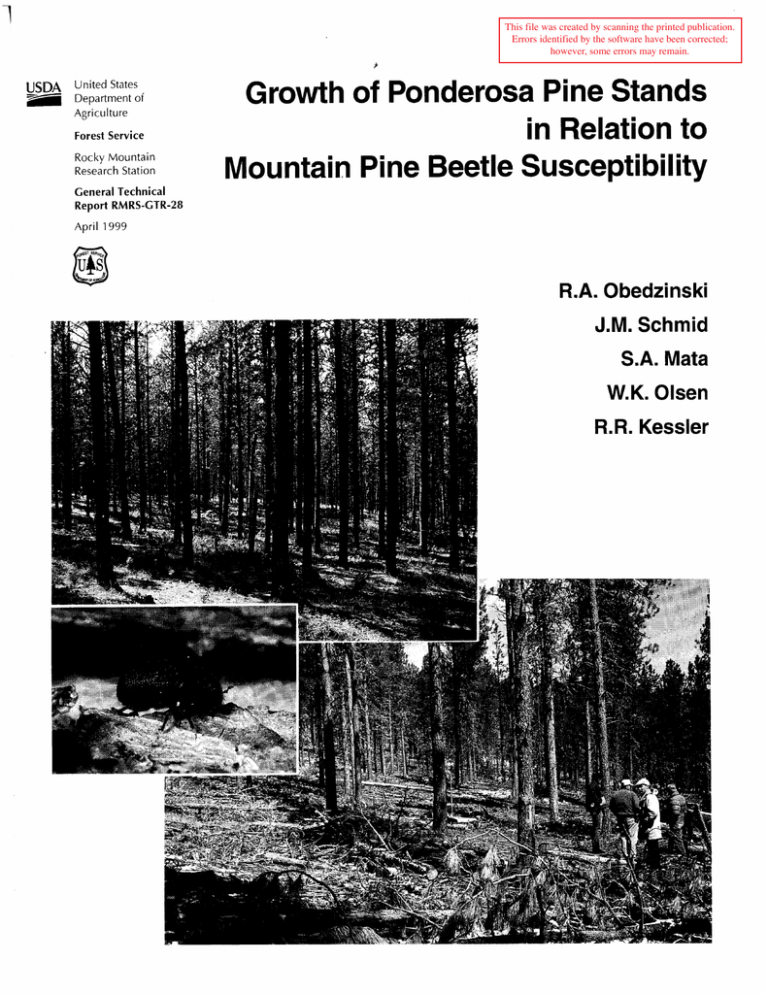
This file was created by scanning the printed publication. Errors identified by the software have been corrected; however, some errors may remain. USDA -= United States Department of Agriculture Forest Service Rocky Mountain Research Station Growth of Ponderosa Pine Stands in Relation to Mountain Pine Beetle Susceptibility General Technical Report RMRS-GTR-28 April 1999 R.A. Obedzinski J.M. Schmid S.A. Mata W.K. Olsen R.R. Kessler h Abstract Obedzinski, R.A.; Schmid, J.M.; Mata, S.A.; Olsen, W.K.; Kessler, R.R. 1999. Growth of ponderosa pine stands in relation to mountain pine beetle susceptibility. Gen. Tech. Rep. RMRS-GTR-28. Fort Collins, CO: U.S. Department of Agriculture, Forest Service, Rocky Mountain Research Station. 13 p. Ten-year diameter and basal area growth were determined for partially cut stands at 4 locations. Average diameters in the partially cut plots generally increased by 1 inch or more, while average diameter in the uncut controls increased by 0.9 inches or less. Individual tree growth is discussed in relation to potential susceptibility to mountain pine beetle infestation. Basal area increases ranged from 0.9 to 1.9 ft2/acre/ yr in partially cut plots, while basal area increases in the control plots ranged from 0.4 to 1.4 ft2/acre/yr. Endemic mountain pine beetle infestations and snow breakage accounted for most of the mortality on the plots, which decreased the residual basal area and basal area growth. Increases in basal area are used to estimate the length of time required for various stand densities to reach the susceptibility thresholds for mountain pine beetle infestation. Stand marking may influence future susceptibility to beetle infestations. Keywords: Ponderosa pine, basal area growth, diameter growth, mountain pine beetle, stocking levels The Authors - - R.A. Obedzinski is a Silviculturist, Fremont National Forest, Lakeview, Oregon 97630. J.M. Schmid is an Entomologist (retired) Rocky Mountain Forest and Range Experiment Station, Fort Collins, Colorado 80526. S.A. Mata is a Forestry Technician, Rocky Mountain Forest and Range Experiment Station, Fort Collins, Colorado 80526. W.K. Olsen is a Forestry Consultant, Advanced Forestry, 247 Falls Creek Drive, Bellvue, Colorado 80512. R.R. Kessler is a Consulting Forester, Route 1, Box 50B, Custer, South Dakota 57730. You may order additional copies of this publication by sending your mailing information in label form through one of the following media. Please specify the publication title and General Technical Report number. Fort Collins Service Center Telephone (970) 498-1719 FAX (970) 498-1660 E-mail Web site Mailing Address rschneider/rmrs@fs.fed.us http://www.xmission.com/-rmrs Publications Distribution Rocky Mountain Research Station 3825 E. Mulberry Street Fort Collins, CO 80524 Cover: Unthinned stands (top) usually infested by the mountain pine beetle, although thinned stands (bottom) are less susceptible. (Photos from the Black Hills, SD.) Growth of Ponderosa Pine Stands in Relation to Mountain Pine Beetle Susceptibility RIAmObedzinski JIM. Schmid SIAmMata WmKm Olsen R.R. Kessler Contents Introduction .................................................................................................................. Methods ...................................................................................................................... Results and Discussion ............................................................................................... Diameter Growth ............................................................................................ Basal Area Growth ......................................................................................... MPB Susceptibility Estimates ......................................................................... Management Implications ........................................................................................... Literature Cited ............................................................................................................ Introduction Knowledge of tree growth under various stand and site conditions is essential for managing ponderosa pine, Pinus ponderosa Lawson, stands. Such knowledge is absolutely necessary for the development of growth and yield models that are used to predict future outcomes for different silvicultural scenarios. This knowledge is also useful fbr predicting when partially cut stands may become susceptible to infest a t i o n by t h e m o u n t a i n p i n e beetle (MPB), Dendroctonus ponderosae Hopkins. High susceptibility of ponderosa pine stands has been associated with basal areas ,150 ft2/acre (Sartwell and Stevens 1975), but recent evidence suggests that the basal area threshold for high susceptibility may be as low as 120 ft2/acre (Schmid and Mata 1992). Lacking actual growth data for partially cut stands of susceptible size, Schmid (1987) used a growth and yield program for even-aged stands called RMYLD (see Edminster 1978) to estimate when partially cut ponderosa pine stands of specific densities would reach basal area of 150 ft2/acre.Based on the number of trees i n each experimental stand and the site indices for the stands, RMYLD estimated t h a t a ponderosa pine stand with basal area of 60 took 76 yr, a stand with basal area of 80 took 51 yr, and a stand with basal area of 100 required 37 yr to reach basal areas equal to 150 ft2/acre (Schmid 1987). This paper reports on the 10-yr diameter and basal area growth of partially cut stands a t 4 locations in the Black Hills of South Dakota. The results are discussed in relation to future susceptibility of ponderosa pine stands to MPB populations, future management schedules for keeping stands below the high susceptibility threshold, and the microcosm stand concept of Olsen et al. (1996). Methods During a study regarding the relationship between stand density and MPB-caused tree mortality, sets of growing stock level (GSL) plots were installed in susceptible-size ponderosa pine stands in the Black Hills of South Dakota (Schmid et al. 1994). Each set typically consisted of 4 2.47-acre plots; 3 plots partially cut to different GSLs and the fourth plot left uncut to serve as a control. Leave trees within cut plots were selected on the basis of diameter, spacing, crown development, and visually apparent good health. Tree selection emphasized leaving the best and largest trees as evenly spaced as possible. The marlung crew tried to leave the basal area a t k1 of the designated level (i.e., a GSL 80 stand would be between 79 and 81). When the plots were installed, the ce*tral 1.25 acres of each plot were designated a s the central USDA Forest Service Gen. Tech. Rep. RMRS-GTR-28. 1999 inventory plot (CIP). Diameter a t breast height (DBH)was measured on all trees within the CIP. Tree diameters and information on the presence or absence of MPB attacks, crown form, defects, and diseases were recorded. Metal tags were placed on the designated leave trees in the CIP to facilitate record keeping in regard to MPB infestation and the determination of individual tree growth in subsequent years. Trees in the CIP provided the growth information and were t h e basis for basal area and diameter growth statements for the 2.47-acre plot. Trees in the plots were also examined for the presence of MPB attacks during the annual surveys after cutting. Trees with MPB attacks were classified as successfully attacked or pitchout ( a tree that has external evidence of MPB attacks but usually survives the attacks); the trees were examined the following year to verify the classification. In 1985, the Brownsville plots (BRN) were installed in the northern Black Hills about 9 miles southeast of Deadwood. Three plots were partially cut to GSL 60, GSL 80, and GSL 100 in May 1986, while the fourth plot was left uncut as the control a t GSL 146. Site index for the GSL 60 was 64, the GSL 80 was 58, the GSL 100 was 56, and for the control was 68. The plots were remeasured in September 1990 and September 1985. I n 1 9 9 5 , l tree i n the GSL 60 and 1 tree in the GSL 80 had been attacked by MPBs. These trees were included in computations because they were not dead when the plots were inventoried. In 1985, the Crook Mountain plots (CRK) were installed in the northern Black Hills about 6 miles northeast of Deadwood. Three plots were cut to GSL 80, GSL 100, and GSL 120 in December 1986, while the fourth plot was left uncut a t GSL 158. Site index for the GSL 80 was 71, the GSL 100 was 72, the GSL 120 was 66, and for the control was 69. Loggers mistakenly cut 1leave tree in the GSL 120 plot but also left trees in the GSL 80 and GSL 100 plots. This increased the GSLs in these 2 plots to more than the designed GSL + l ; specifically, to GSL 84.8 and 104.5. This paper will refer to these plots as GSL 80 and GSL 100 although stocking levels were above the design level. The GSL 80 plot sustained MPB-caused mortality of3 trees, the GSL 100 had 4 MPB-killed trees, and the GSL 120 plot sustained 1 MPB-killed tree within their CIPs in 1985 after they were inventoried, but before they were cut. The MPB-attacked trees were not cut by the loggers because they were marked as leave trees. Beetle activity ceased after the cutting and was not evident until the 1996 inventory. The plots were not remeasured after 5 yr, but they were remeasured for 10-yr growth on September 4, 1996. In 1985, a 2.47-acre plot (C-C plot) was established in a ponderosa pine stand about 8.5 miles south of Deadwood. The stand and surrounding area had been thinned under a commercial timber sale some years prior. The Black Hills National Forest (BHNF) normally thins to a basal area of about 80 ft2/acre but permits the basal area of leave trees to be k10 ft2 of the designated level (for example, 80 +lo). The plot's basal area at the time of plot installation was about 83 ft2/acre. Considering basal area growth rates and the BHNF's marking guideline of 80 f 10 ft2, the basal area after thinning was probably below 80 ft2 and closer to 70 ft2/acre. In addition, tree densities within different parts of the plot were not as uniform as they are in the Brownsville, Border, and Crook Mountain plots because the basal area in subsections of the plot ranged from 66 to 100 ft2/acre. All trees within the 2.47-acre plot were inventoried in September 1985 and again on May 16, 1996. One 1984 MPB-attacked and 4 1985 MPB-attacked trees were present when the plot was inventoried in 1985. The C-C plot was about 0.5 mile north of the BRN plots, which allowed evaluation of MPB infestations and growth under different levels of marking precision (i.e., BA 80+10 of this plot versus the BA 80+1of the BRN GSL 80). Because the plot was within a large thinning area and no uncut stands were available in the immediate vicinity, a control plot was not installed. In 1986, the Border plots (BOR) were installed along the Wyoming-South Dakota border on Schoolhouse Gulch Road about 6.5 miles southwest of Savoy, South Dakota. Three of the plots were cut to GSLs of 60, 80, and 100 in July 1987 while the fourth plot was left uncut at GSL 207. Site index for the GSL 60 was 73, for GSL 80 was 71, for GSL 100 was 76, and for the control was 71. The GSL 60 and GSL 80 had been partially cut some years prior so their precutting GSLs were in the 140 to 160 range, whereas the GSL 100 and the control had original GSLs of over 200. The plots and stands in the area surrounding the plots were subject to a wet snow accompanied by strong winds in March or April 1996. Although windthrown and broken-top trees were present in the cut plots, especially the GSL 100, none of the damaged trees within the plots were salvaged. The plots were remeasured on August 26, 1997. Diameter growth was based on trees within the CIP and was calculated for only those trees alive a t the time of remeasurement. The diameter growth of each tree was calculated by subtractingits diameter at the time the plots were installed from its diameter a t the time of remeasurement. Some trees had smaller diameters at the time of remeasurement than they had when the plots were installed. We considered this situation to result from measurement error and assigned such trees zero growth. Trees dying during the measurement period were not included in the calculations of mean diameter growth. Basal area values for the partially cut GSLs a t the 4 locations were used to estimate when each GSL might reach the MPB-susceptibility thresholds of 150 and 120 ft2/acre. For each plot, the basal area at the time when the plots were installed was considered the initial basal area when time equaled zero; the basal area approximately 10 yr later was considered the basal area 10 yr after cutting. Trees that were dead when the plots were remeasured were not included in the 10-yrcomputations ofbasal area. Straight lines were drawn through the 2 points in the respective figures, and extended until they intercepted the 120 and 150 basal area values. As noted, the CRK and C-C plots had live but MPBattacked trees at the time of inventory or cutting. If the basal area for these trees is incorporated into the initial basal area for the plots, straight-line projections for the plots would be misrepresented because these trees did not grow during the years following MPB attack. Thus, the basal area associated with the MPB-attacked trees should be withdrawn from the computations. However, these trees were generally alive at the time of initial inventory so their basal area can be considered part of the initial basal area and incorporated into the computations. Because comparison of these 2 situations provides insight into the influence of endemic MPB-caused mortality on stand growth and basal area growth, susceptibility estimates are presented and discussed for both situations. Straight-line projections may underestimate the time required to reach the susceptibility thresholds because they do not include subsequent tree mortality. To determine if our projections differed substantially from those derived from a growth and yield model, we compared the predictions from the straightline projections to those of GENGYM. GENGYM is a computerized growth and yield model used for projecting future stand conditions in ponderosa pine stands (Edminster et al. 1990). GENGYM supercedes RMYLD, which was used by Schmid (1987) to estimate the time for stands in the Brownsville plots to reach susceptibility thresholds. Results and Discussion Diameter Growth Mean diameter increased in all plots; even those with MPB-caused tree mortality (table 1). Mean diameter growth in most of the cut plots generally exceeded 1 inch during the first 10 yr, while mean diameters in the control plots grew ~ 0 . inch 9 (table 1). Brownsville. Average growth rates by diameter class were very similar among diameter classes within each cut plot at BRN except for the smallest and largest USDA Forest Service Gen. Tech. Rep. RMRS-GTR-28. 1999 Table 1-Periodic (GSL). GSL~ BRN 60 BOR 60 BRN 80 BOR 80 CRK 80W CRK 8 0 W 0 C-C 80 W C-C 80 WO BRN 100 BOR 100 CRK l 0 0 W CRK 100 WO CRK 120W CRK 120 WO BRN Control BOR Control CRK Control annual increment (P.A.I.) in mean diameter in inches by growing stock level Mean diameter P.A.I. Start 5 Yr 10 yr 5 Yr 10 yr -------------------------inches-----------------------12.4 10.9 11.5 10.8 13.7 13.7 13.1 NA~ 12.0 NA NA NA 13.8 13.1 12.5 12.9 15.3 15.5 0.14 NA 0.10 NA NA NA 0.1 4 0.22 0.10 0.21 0.16 0.18 12.6 NA 13.3 NA 0.07 a~~~ = Brownsville plots, BOR = Border plots, CRK = Crook Mtn. plots, C-C = Black Hills National Forest standard thinning plot. GSLs followed by a W (with) have MPB-killed trees incorporated into the diameter values, while those followed by a WO (without) have these trees withdrawn. b~~ = data unavailable. classes where the diameter class was represented by only 1or 2 trees (table 2). Within the control, average growth rates increased withincreasing diameter class. Among GSLs, the mean growth rate within each diameter class decreased from the GSL 60 to the control (table 2). The smallest and largest values for the 10-yr growth within the diameter classes also decreased from the GSL 60 to the control (table 3). Except for the lone 9 inch tree (table 2), the smallest 10-yr growth for trees in the other diameter classes in the GSL 60 was 0.6 inch and the largest was 2.2 inches (table 3); the majority of the trees grew 1inch or more. Table 2-Mean diameter growth (XfSD) in inches by 1-inch diameter class for different GSLs at Brownsville (BRN) based on 10-yr growth data. Diameter al tree sample b2tree sample GSL 60 GSL 80 \ USDA Forest Service Gen. Tech. Rep. RMRS-GTR-28. 1999 GSL 100 Control Table 3-Range of 10-yr growth rates by diameter class for different GSLs at Brownsville (BRN). Diameter GSL 60 GSL 80 GSL 100 Control --- a~ zero value for the low end of the range indicates that the diameter of at least 1 tree did not change measurably. In contrast, no measurable growth or growth of only 0.1 inch.110-yr was common in diameter classes in the BRN control. The largest 10-yr growth for any tree in the control was 1.7 inches, but the majority of trees in all diameter classes grew less than 1inch. Crook Mountain. Average growth rates by diameter class were similar among diameter classes within the CRK cut plots except for those classes represented by only 1or 2 trees (table 4). Average growth rates within the control increased as diameter class increased. Among GSLs, mean growth rate within each diameter class was greatest in the GSL 80 and lowest in the control (table 4). Although mean growth rate within the same diameter class decreased from the GSL 80 to the control in several diameter classes, this trend was not as uniform in all CRK diameter classes as it was in the BRN plots (tables 3 and 5). Three growth characteristics for the CRK plots contrast sharply with the same characteristics for the BRN plots. Some trees in each of the CRK plots grew more than 2.0 inches in diameter in 10 yr (table 5 ) whereas trees growing more than 2 inches in the BRN plots were confined to the BRN GSL 60 and 80 (table 3). Similarly, some trees in each of the CRK plots showed no measurable increase in growth or Table 4-Mean diameter growth (Xf SD) in inches by 1-inch diameter class for different GSLs at Crook Mountain (CRK) based on 10-yr growth data. Diameter GSL 80 -- GSL 100 GSL 120 Control - \ al tree sample USDA Forest Service Gen. Tech. Rep. RMRS-GTR-28. 1999 Table 5-Range of 10-yr growth rates by diameter class for different GSLs at Crook Mountain (CRK). Diameter GSL 80 GSL 100 GSL 120 Control - - - - - - - - - - - - - - inches - - a~ zero value for the low end of the range indicates that the diameter of at least 1 tree did not change measurably. Ranges are not presented for diameter classes represented by only 1 tree. grew only 0.1 inches in 10 yr (table 5) whereas trees with no measurable growth in the BRN plots were mainly confined to the BRN control. Within the same diameter class at BRN, the upper and lower ends of the range in growth generally declined from the lowest GSL to the highest GSL but this trend was not consistent among all the diameter classes in the CRK GSLs (tables 3 and 5). An explanation is not readily evident, but the CRK plots have a greater number of diameter classes in respective GSLs, which indicates that the CRK stands were more diverse than the relatively homogeneous BRN stands. Whether this diversity led to more variability in diameter growth is unknown. C-C. Average growth rates increased with increased diameter in the C-C plot (table 6). Diameter growth rates for trees >10 inches were similar to those for the BRN GSL 80, which is about 0.5 miles away. The range in diameter growth by diameter class in the C-C plot was also similar to that in the BRN GSL 80 except that the C-C plot had more diameter classes with no measurable increase (tables 3 and 6). Table 6-Range of 10-yr growth rates and mean diameter growth by diameter class for the Black Hills National Forest standard thinning plot (C-C). Diameter class Range Mean + SD dltree sample b~ zero value for the low end of the range indicates that the diameter of at least 1 tree did not change measurably. USDA Forest Service Gen. Tech. Rep. RMRS-GTR-28. 1999 Table 7-Mean diameter growth (XfSD) in inches by 1-inch diameter class for different GSLs at the Border location (BOR) based on 10-yr growth data. Diameter GSL 60 GSL 80 GSL 100 Control al tree sample Border. Average diameter growth rates were similar among diameter classes within each partially cut BOR plot but increased with increased diameter in the BOR control (table 7). This result corresponds to that in the BRN and CRK plots. Nearly all trees in the cut plots grew at least 0.5 inches or more, while some trees in 8 of the diameter classes in the BOR control showed no measurable growth (table 8). Within a specific diameter class, the high and low ends of the range decreased from the GSL 80 to the control. These changes in the diameter growth ranges for the BOR plots also followed a pattern similar to ranges for the BRN and CRL plots. What do these growth rates mean in regard to individual tree susceptibility and what trees become primary focus trees for the MPB in unmanaged and managed stands? In previous work on White House Gulch plots in the Black Hills, Olsen et al. (1996) noted that high density clumps of trees exhibiting a range of diameters existed within a relatively homogeneous unmanaged stand. These clumps, which they called microcosm stands, contained some trees disadvantaged by competition and disease. Growth rates for these trees were probably low regardless of their diameter. Because of their physiological condition, these trees are more susceptible to MPB attack and are more likely to function as primary focus trees. Table 8-Range of 10-yr growth rates by diameter class for different GSLs at the Border location (BOR). Diameter GSL 60 GSL 80 GSL 100 Control a~ zero value for the low end of the range indicates that the diameter of at least 1 tree did not change measurably. Ranges are not presented for diameter classes represented by only 1 tree. USDA Forest Service Gen. Tech. Rep. RMRS-GTR-28. 1999 Within the control plots at BRN, CRK and BOR, some trees within all diameter classes exhibited minimal or no measurable growth over the 10-yr period (tables 3,5, and 8). Thus, if diameter growth in these plots is an indicator of susceptibility for trees in unmanaged stands, highly susceptible trees are found in a wide range of diameter classes. In managed stands represented by the cut plots, competition is less noticeable because the number of diameter classes having minimal or no measurable growth is less frequent than in the unmanaged stands. In addition, the average rate of diameter growth is similar among the diameter classes in each GSL, whereas it increased as diameter increased in the unmanaged stands (tables 2,4, and 7). However, comparison of the average growth rates in the various diameter classes in plots with the lowest stocking to those of plots with greater stocking at the same location indicates that competition may be occurring in the higher density cut plots. For example, comparison of the growth rates in the BRN GSL 60 to the growth rates in the respective diameter classes in the other BRN GSLs (table 2) indicates that trees in the GSL 80 and GSL 100 are apparently competing even though partial cutting increased spacing. As the stockmg level increases from the GSL 80 to the GSL 100, average diameter growth is reduced further as spacing is reduced. Although this trend is less evident in the CRK and BOR plots, similar relationships appear to exist (tables 4 and 7). In general, competition increases as stand density increases (as GSL increases). More importantly, 10-yr growth rates for individual trees in the cut plots at BRN, CRK, C-C, and BOR show considerable variability within all diameter classes (tables 3, 5, 6, and 8), as they did in the control plots, although the number of trees with minimal increases in diameter is less than that in the unmanaged situation. Despite the increased spacing and decreased competition, some trees in most diameter classes grew rather poorly and thus, may be more susceptible to MPB attack. Future inventories of these plots representing managed stands will determine if trees with low growth rates become the primary focus trees for the MPB and if the higher density areas within the C-C plot become the microcosm stands as suggested by Olsen et al. (1996). Situations within the BRN and C-C plots provide contrasting arguments for and against the Olsen et al. hypothesis. First, 3 trees in the BRN cut plots were attacked by MPBs in the summers of 1995 and 1996. One tree grew 0.8 for the 10 yr. This tree grew 0.6 inches during the first 5 yr but only 0.2 inches in the second 5 yr. Secondly, MPB-caused mortality in the C-C plot generally occurred in subsections of the plot with higher stocking levels. These 2 results support the Olsen et al. hypothesis. USDA Forest Service Gen. Tech. Rep. RMRS-GTR-28. 1999 In contrast, the evidence from the other 2 MPBattacked trees in the BRN GSL 80 is not supportive because both grew over 1.2 inches for the 10 yr, grew relatively well in the second 5 yr, and neither had evidence of Armillaria in the bole at ground level. Growth rate did not apparently influence MPB attacks on these trees. Concurrent with these 2 MPBattacked trees, a tree in the BRN GSL 60 died in 1996 with evidence of Armillaria and Ips but without evidence of MPB (J.M. Schmid 1996, personal observation). During the first 5 yr of growth after partial cutting, this tree grew 0.7 inches but thereafter, measurable growth was not evident. The evidence suggests that Armillaria invaded the root systems about 5 yr into the 10-yr growth period and sharply curtailed growth during the next 5 yr. Presumably, this tree would be highly susceptible to MPB attack if growth rate is an indicator of susceptibility. Why the tree was not attacked is not readily explainable except that MPB populations in the vicinity of the BRN plots were endemic and the 1995 attacks on other trees just outside the plots may have drawn beetles away from this tree. This suggests that every predisposed or more susceptible tree may not always be attacked by the MPB because endemic MPB populations may be insufficient to attack them. Such trees may die from the effects of the Armillaria infection, Ips attacks, or other agents before MPBs attack. Olsen et al. (1966) suggested that large diameter ponderosa pine trees are not always the primary focus trees. Although the numbers of MPB-killed trees in each of the CRK plots were small compared to the total number, the increases in mean diameter (table 1)indicates the MPB was not exclusively infesting the largest diameter trees. If only the largest diameter trees were being killed, mean diameter would not be appreciating a t a rate similar to comparable noninfested plots. Selection of a range of tree diameters by the MPB further supports the claim by Olsen et al. (1996) that large diameter trees are not always the primary focus trees. Basal Area Growth Basal area increased in all plots in the 4 locations; MPB-caused tree mortality during the 10 yr was insufficient in those plots where it occurred to decrease total basal area below the initial level (table 9). Basal area increased uniformly in the BRN cut plots (ca. 13 ft2/acre/10 yr), while increases were more variable among the CRK and BOR cut plots (table 9). When MPB-caused mortality is withdrawn from the starting basal area in the CRK plots, basal area increased more in the CRK and BOR plots than in the BRN plots (table 9); probably because both locations were better sites. Basal area growth was about the same in the BRN and C-C GSL 80 plots when MPBcaused mortality is deleted from the C-C plot. Table 9--Periodic annual increment (P.A.I.) in basal area by growing stock level (GSL). GSL~ Start Basal area 5 Yr P.A.I. 10 yr 5 Yr 10 yr -----------------------fiZperacre---------------------BRN 60 BOR 60 BRN 80 BOR 80 CRK 80W CRK 8 0 W 0 C-C 80 W C-C 80 WO BRN 100 BOR 100 CRK 100W CRK 100 WO CRK 120W CRK 120 WO BRN Control BOR Control CRK Control 60.5 60.1 80.8 80.1 84.8 82.2 83.6 81.7 100.7 98.3 104.5 98.6 119.1 117.4 146.1 206.6 158.1 66.8 NA~ 86.9 NA NA NA NA NA 106.6 NA NA NA NA NA 149.3 NA NA 73.6 78.3 93.8 97.7 100.2 100.2 92.9 92.9 113.4 108.2 115.1 115.1 136.8 136.8 155.3 21 1.1 172.1 1.26 NA 1.22 NA NA NA NA NA 1.18 NA NA NA NA NA 0.64 NA NA 1.31 1.82 1.30 1.76 1.54 1.80 0.93 1.12 1.27 0.99 1.06 1.65 1.77 1.94 0.92 0.45 1.40 a ~ = Brownsville R ~ plots, BOR = Border plots, CRK = Crook Mtn. plots, C-C = Black Hills National Forest standard thinning plot. GSLs followed by a W (with) have MPB-killed trees incorporated into the basal area values while those followed by a WO (without) have these trees withdrawn. b~~ = data unavailable Brownsville. During the first 5 yr after cutting, basal area in the 3 cut plots at BRN increased 5.9 to 6.3 ft2/ plot while basal area in the control plot increased 3.2 (table 9). For the second 5-yr period, basal area increased 6.8 to 6.9 ft2in the cut plots, while the control plot increased 6.0 ft2 (table 9). The difference in the growth rates for the control plot appears to be influenced primarily by precipitation patterns because 3 of the first 5 yr had below average precipitation (Schmid et al. 1991), while 3 of the second 5 yr had above average precipitation, which exceeded 138%in 2 of the 3 yr (EarthInfo 1996). Thus, although basal area growth for the control plot was and should be expected to be less than for the cut plots during both periods, basal area growth in an "unthinned stand" may almost equal growth in "thinned stands" during periods of above-average precipitation. Crook Mountain. Basal area in the CRK plots increased 15.4 ft2/acre in the GSL 80, 10.6 in the GSL 100, and 17.7 in the GSL 120, when the basal area of the MPB-attacked trees was retained in the initial basal areas (table 9). When this basal area is withdrawn, the increases were 18.0 ft2/acrein the GSL 80, 16.5in the GSL 100, and 19.4in the GSL 120 (table 9). The CRK control increased 14.0 ft2/acre (table 9). In general, the P.A.1.s for the CRK plots appears better than P.A.1.s for comparable plots from the other locations. However, because of data variabilit,~,the influence of site remains circumstantial until future 10-yr measurements can be made. C-C. Basal area increased about 9 ft2/acre/10 yr in the C-C plot when the basal area associated wth MPB-attacked trees was retained and about 11 ft2 when it was withdrawn (table 9). The latter increase is slightly less than the increase in the comparable BRN GSL 80 plot (table 9). In the absence of MPB-caused mortality, marking precision did not apparently affect basal area growth. However, when MPB-caused mortality is considered, marking precision may have had an indirect influence. Basal area in different parts of the plot ranged from 66 to 100 ft2/acre in 1985 as a result of marking, and 4 of the 5 MPB-attacked trees were in the higher density areas. Because MPBs are known to attack microcosm stands of higher density (Olsen et al. 1996), the mortality may be partially attributable to the denser clumps left by the marking crews. This suggests that marking crews must be careful not to leave such clumps or they risk creating future pockets of MPB infestations in stands that otherwise are below the susceptibility threshold. Border. Basal area increased 18.2 ft2 in the GSL 60, 17.6 in the GSL 80,9.9 in the GSL 100, and 4.5 ft2 in the control at the BOR location (table 9). The low increase in basal area in the GSL 100 was caused by the 1996 snow/wind storm which uprooted or snapped off more trees in this plot than in the other plots. Bereft USDA Forest Service Gen. Tech. Rep. RMRS-GTR-28. 1999 of this mortality event, these plots would have increased more than 20 ft2 over the 10 yr for a n average of more than 2 ft2/yr. MPB Susceptibility Estimates Based on the 10-yr growth in basal area in the BRN plots, straight-line projections (SLP) indicate the GSL 60 would take about 68 yr, while the GSL 80 would take about 53 yr, and the GSL 100 about 39 yr to reach the basal area threshold of 150 ft2/acre (figure 1). Previous computations using RMYLD estimated periods of 76, 51, and 37 yr for these plots to reach the same threshold (Schmid 1987); the 2 sets of estimates are very similar for the GSL 80 and GSL 100. GENGYM estimates that the GSL 60 would take 90 yr, the GSL 80 would take 59 yr, and the GSL 100 about 43 yr before they reach the basal area level of 150 ft2(table 10).From any of the 3 estimationmethods, the cut stands appear unsusceptible for relatively long periods, if 150 is the critical level. However, if the threshold is reduced to 120 ft2/acre, the SLP suggest the GSL 60 would take about 46 yr, while the GSL 80 would take about 31, and the GSL 100 about 16 yr to reach the threshold (figure 1). GENGYM estimates that the GSL 60 would take 50 yr, the GSL 80 would take 31 yr, and the GSL 100 about 16 yr. Based on 10-yr growth rates in the CRK plots, SLP indicate t h e GSL 80 would take about 42 yr, while the GSL 100 would take 42 yr, and the GSL 120 would take about 17 yr to grow to the basal area threshold of 150 ft2/acre if the basal area associated with MPB-attacked trees is retained as part of the initial basal area (figure 2). If the MPB-caused mortality is withdrawn from the initial basal area, the same plots would reach the same threshold in about 3 8 , 3 l , and 17 yr. GENGYM projections indicate these 3 plots would reach the 150 threshold in 38, 32, and 17 yr with MPB mortality incorporated and 41, 31, and 17 yr with MPB mortality deleted. If the susceptibility threshold is reduced to 120 ft2 and the basal area associated with MPB-attacked trees is retained a s part of the initial basal area, the SLP indicates that t h e CRK GSL 80 would reach this threshold in about 23 yr, while the GSL 100 would take 15 yr (figure 2). GENGYM predicts the GSL 80 would take about 19 yr and the GSL 100 about 11yr. The GSL 120 was essentially a t the threshold immediately after partial cutting, and the MPB-caused mortality did not change the stocking level enough to Figure 1-Years required for stand densities in the Brownsville plots to reach MPB susceptibility thresholds. USDA Forest Service Gen. Tech. Rep. RMRS-GTR-28. 1999 + Table 10-Number of years for various GSLs to reach the susceptibility thresholds of 120 and 150 as derived from straight line and GENGYM projections. LocationIGSL BRN BOR BRN BOR CRK CRK C-C C-C BRN BOR CRK CRK CRK a~~ Basal area 120 Line Proj. GENGYM 60 60 80 80 80W 80W0 80 W 80 WO 100 100 100W 100 WO 120 46 32 31 23 23 21 34 31 16 23 15 13 NA~ Basal area 150 Line Proj. GENGYM 50 25 31 13 19 21 34 36 16 9 11 12 NA 68 48 53 40 42 38 61 55 39 53 42 31 17 90 39 59 24 38 41 70 73 43 23 32 31 17 = data unavailable warrant developing with and without MPB mortality estimates. If the MPB-caused mortality is withdrawn, SLP indicates the GSL 80 and GSL 100 would reach the threshold about 2 yr sooner. GENGYM predicts threshold crossing 1to 2 yr later than their respective projections when mortality is retained. Based on the 10-yr growth, the C-C plot would take about 61 yr to reach the 150 ft2 level and about 34 yr to reach the 120 ft2 level if the basal area associated with MPB-attacked trees is retained as part of the initial basal area (figure 3). For the same conditions, GENGYM indicates about 70 and 34 yr (table 10). If ---*--- GSL BOW GSL BOW0 GSL 100W GSL 100WO GSL120W GSL120WO --...'&--.0 ---I.---.--A .--- Figure 2-Years required for stand densities in the Crook Mountain plots to reach MPB susceptibility thresholds. GSLs followed by a W represent the projection when the MPB-attacked trees are incorporated into the initial basal area. GSLs followed by a WO represent the projection when the MPB-attacked trees are deleted from the initial basal area. USDA Forest Service Gen. Tech. Rep. RMRS-GTR-28. 1999 0 5 10 15 20 25 30 35 40 45 50 55 60 65 70 Years Figure 3-Years required for the C-C plot to reach MPB susceptibility thresholds. C-C 80W line represents the projection when the MPB-attacked trees are incorporated into the initial basal area. C-C 80W0 line represents the projection when the MPB-attacked trees are deleted from the initial basal area. the MPB-caused mortality is withdrawn, the plot may reach the 150 ft2 level in about 55 yr and the 120 ft2 level in about 31 yr. MPB-caused mortality thus, increases the time to reach the 150 ft2level by about 6 yr and the time to reach the 120 f l 2 level by 3 yr. Comparing GSLs of the same level with endemic MPB-caused mortality excluded, the CRK GSL 100 would reach the critical thresholds for MPB epidemics sooner than the BRN GSL 100 probably because the CRK plot was on a better site. Similarly, the CRK GSL 80 would reach the critical thresholds sooner than the BRN and C-C GSL 80s probably because the CRK plot was on a better site and the initial diameters were generally greater. The BRN and C-C GSLs 80 reached the thresholds in almost identical times; apparently marking precision did not influence stand performance in regards to growth (figures 1 and 3). It remains to be seen, however, if the 2 plots will function similarly during future MPB infestations or whether the microcosm stands created in the C-C thinned stand by less precise markmg will increase susceptibility of the C-C stand and cause it to function like an unthinned stand. Straight-line projections indicate the BOR GSL 60 will cross the 150 threshold in 48 yr, while the BOR GSL 80 will take 40 yr, and the BOR GSL lOOwill take 53 yr (figure 4). GENGYM estimates the 3 plots will USDA Forest Service Gen. Tech. Rep. RMRS-GTR-28. 1999 cross the same threshold in 39,24, and 23 yr. For the 120 threshold, SLP indicate the GSL 60 will cross the threshold in 32 yr, while both the GSL 80 and GSL 100 will take 23 yr. GENGYM estimates the 3 plots will cross the same threshold in 25, 13, and 9 yr. The substantial disparity between comparable estimates for each BOR GSL occurs because ofthe way GENGYM computes future conditions. GENGYM uses the initial stand conditions (in this case, the stand conditions existing after the stands were partial cut) and 10-yr growth rates. GENGYM assumes a minimal amount of tree mortality over the duration of the simulation but does not incorporate substantial mortality events such as MPB infestations or snow/wind storms. In the BOR plots, the April 1996 storm killed 10 or more trees in each plot; more than 30 in the GSL 100. This mortality causes the disparity between the 2 methods and also explains why the BOR GSLs did not cross the 2 thresholds in timeframes similar to comparable GSLs from the other locations. Except for the BOR plots, comparable estimates from the SLP and GENGYM methods exhibit the greatest disparity when the 150 threshold is being considered (table 10).Most of the disparity appears to be caused by differences between stand growth/ mortality relationships in the 2 methods. The straightline method (SLP) assumes no tree mortality over the 0 10 20 30 40 50 60 Years Figure $-Years required for stand densities in the Border plots to reach MPB susceptibility thresholds. Snow breakage decreased the number of trees on the partially cut plots but was especially deleterious to the stocking on the GSL 100. time of the projection, while GENGYM incorporates mortality in the timeframe of the projection. No tree mortality is unrealistic because trees die during the life of a stand. The assumption of no mortality is probably insignificant in the 20 to 30 yr timeframe that exists when the 120 threshold is used and explains why the estimates from the 2 methods are so similar when this threshold is being considered. However, when projections are made for 40 to 50 or more yr, as is the case when the 150 threshold is used, the no mortality assumption in the SLP method will cause it to underestimate the time required to cross the threshold. SLP projections also underestimate the time required to reach the susceptibility thresholds because basal area growth (P.A.I.)will decrease in thinned plots over time (W.K. Olsen 1996, personal communication),but the method assumes the same rate of growth throughout the length of the projection. In addition to the loss of basal area attributed to treemortality, basal area growth will decrease because it decreases as age increases (see Boldt and Van Deusen 1974). As tree diameter increases with age, the annual increment in diameter becomes less. Thus, our stands and similar stands in the Black Hills National Forest would reach critical susceptibility levels slightly later than our gtraight line projections indicate. Management Implications Even though some disparity occurs in the estimates, forest managers should be aware of the relationships between threshold levels for epidemic MPB populations, stand growth, and reentry intervals for partially cut stands. Stand growth in terms of basal area per year varies among stands, but growth rates of 1.3 or more fi2/yr are possible in partially cut stands (table 9). If 150 ft2 of basal area is considered the threshold level for epidemic MPB populations, stands increase a t >1.5 fi21yr,and reentry is scheduled about every 20 yr after the original partial cutting, then stands with GSLs >I20 could exceed the threshold level before the first reentry at 20 yr (table 10). Similarly, stands with GSLs <I20 but >80 (table 10) may exceed the threshold level between the first and second reentry period (40 yr) and should be cut. However, if the threshold for susceptibility is lowered to 120 ft2/ acre, as Schmid and Mata (1992) suggest, then most GSL 100 stands would reach this susceptibility threshold before the first scheduled reentry (20 yr) (table 10, figures 1, 2, and 3). Thus, reentry in the GSLs >I00 may be necessary before the first scheduled reentry at 20 yr, while reentry in the GSL 80 may be necessary halfway between the first and second reentrys. USDA Forest Service Gen. Tech. Rep. RMRS-GTR-28. 1999 These relationships between thresholds for epidemic MPB populations and reentry schedules do not mean that a specific stand must be automatically reentered just because the stand basal area has exceeded the threshold. While it is good management practice to do so, stands exceeding the threshold could be left for a few years as long as managers increase their vigilance for MPB activity in such stands and are able to readily adjust their silvicultural activities if epidemic MPB infestations appear. History indicates, however, that stands allowed to exceed the thresholds become the ignition points for subsequent MPB epidemics. Ignoring such stands and leaving them until the normal reentry occurs is inviting a MPB epidemic. Whether SLP or GENGYM projections are most accurate will eventually be resolved when partially cut susceptible-size stands grow for 50 or more yr, reach the critical susceptibility thresholds, and the amount of tree mortality attributable to endemic MPB populations during the time span is identified. Endemic MPB mortality obviously influences growth projections for both methods. In a GSL 80 stand, 1ft2 of MPB-caused mortality may alter SLP estimates for crossing the 150 threshold 4 to 6 yr (figures 2,3). The same mortality in the GENGYM model will alter its estimates by 3 yr (table 10). Until the influence of endemic MPB mortality is determined, forest managers should be cognizant that different stand growth scenarios can be derived from the 2 methods. Forest managers should also realize that although endemic MPB populations may kill a few trees and thereby reduce the overall basal area of a stand as well as the time to reach the critical susceptibility threshold in the short term, the long-term result may be development of relatively homogeneous stands containing microcosm stands of greater densities as described by Olsen et al. (1996). Such stands are highly conducive to MPB epidemics. This situation is not likely to occur when trees are uniformly spaced. However, if the original marking tends to leave variable tree densities, as is evident in the C-C plot, then the potential for the development of relatively homogeneous stands containing microcosm stands is greater. Overall, the GSL may be below the susceptibility threshold but, within the microcosm stands, it may exceed the threshold. Thus, managers should not be lulled into thinking that because overall stocking is below the threshold, substantial time exists before MPB infestations may become evident. Literature Cited Boldt, C.E.; Van Deusen, L.L. 1974. Silviculture of ponderosa pine in the Black Hills. Res. Paper RM-124. Fort Collins, CO: USDA Forest Service, Rocky Mountain Forest & Range Experiment Station, 43 p. EarthInfo. 1996. NCDC summary of the day information for Lead, South Dakota. CD ROM diskette on file at the Atomspheric SciencesLibrary of Colorado State University, Foothills Campus, Fort Collins, Colorado, 80521. Edminster, C.E. 1978. RMYLD: computation of yield tables for even-aged and two-storied stands. Res. Paper RM-199. Fort Collins, CO: USDA Forest Service, Rocky Mountain Forest and Range Experiment Station, 26 p. Edminster, C.E.; Mowrer, H.T.; Schuler, T.M.; Olsen, W.K.; Hawksworth, F.G. 1990. GENGYM: a variable density stand table projection system calibrated for mixed conifer and ponderosa pine stands in the Southwest. Res. Paper RM-297. Fort Collins, CO: USDA Forest Service, Rocky Mountain Forest and Range Experiment Station, 32 p. Olsen, W.K.; Schmid, J.M.; Mata, S.A. 1996. Stand characteristics associated with mountain pine beetle infestations in ponderosa pine. Forest Science 42: 310-327. Sartwell, C.; Stevens, R.E. 1975.Mountain pine beetle in ponderosa pine: prospects for silvicultural control in second-growthstands. Journal of Forestry 73:136-140. Schmid, J.M. 1987. Partial cutting in MPB susceptible stands: will it work and for how long? In Troendle, C.A.; Kaufmann, M.R.; Hamre, R.H.; Winokur, R.P./ tech. coordinators. Management of subalpine forests: Building on 50 years of research. Proceedings of a technical conference, 6-9 July 1987, Silver Creek, CO. Fort Collins, CO: USDA Forest Service, Rocky Mountain Forest and Range Experiment Station. Gen. Tech. Rep. RM-149: 243-245. Schmid, J.M.; Mata, S.A.; Edminster, C.B. 1991. Periodic annual increment in basal area and diameter growth in partial cut stands of ponderosa pine. Res. Note RM-509. Fort Collins, CO: USDA Forest Service, Rocky Mountain Forest and Range Experiment Station. 3 p. Schmid, J.M.; Mata, S.A. 1992. Stand density and mountain pine beetle-caused tree mortality in ponderosa pine stands. Res. Note RM-515.Fort Collins, CO: USDAForest Service,Rocky Mountain Forest and Range Experiment Station. 4 p. Schmid, J.M.; Mata, S.A.; Obedzinski, R.A. 1994. Hazard rating ponderosa pine stands for mountain pine beetles in the Black Hills. Res. Note RM-529. Fort Collins, CO: USDA Forest Service, Rocky Mountain Forest and Range Experiment Station. 4 p. 13 USDA Forest Service Gen. Tech. Rep. RMRS-GTR-28. 1999 +US. GOVERNMENT PRINTING OFFICE: 1999-844-542 RMRS ROCKY MOUNTAIN RESEARCH STATION The Rocky Mountain Research Station develops scientific information and technology to improve management, protection, and use of the forests and rangelands. Research is designed to meet the needs of National Forest managers, Federal and State agencies, public and private organizations, academic institutions, industry, and individuals. Studies accelerate solutions to problems involving ecosystems, range, forests, water, recreation, fire, resource inventory, land reclamation, community sustainability, forest engineering technology, multiple use economics, wildlife and fish habitat, and forest insects and diseases. Studies are conducted cooperatively, and applications may be found worldwide. Research Locations Flagstaff, Arizona Fort Collins, Colorado* Boise, Idaho Moscow, Idaho Bozeman, Montana Missoula, Montana Lincoln, Nebraska Reno, Nevada Albuquerque, New Mexico Rapid City, South Dakota Logan, Utah Ogden, Utah Provo, Utah Laramie, Wyoming *Station Headquarters, 240 West Prospect Road, Fort Collins, CO 80526 The U.S. Department of Agriculture (USDA) prohibits discrimination in all its programs and activities on the basis of race, color, national origin, gender, religion, age, disability, political beliefs, sexual orientation, and marital or familial status. (Not all prohibited bases apply to all programs.) Persons with disabilities who require alternative means for communication of program information (Braille, large print, audiotape, etc.) should contact USDA’s TARGET Center at 202-720-2600 (voice and TDD). To file a complaint of discrimination, write USDA, Director, Office of Civil Rights, Room 326-W, Whitten Building, 14th and Independence Avenue, SW, Washington, DC 20250-9410 or call 202-720-5964 (voice or TDD). USDA is an equal opportunity provider and employer. Federal Recycling Program Printed on Recycled Paper
